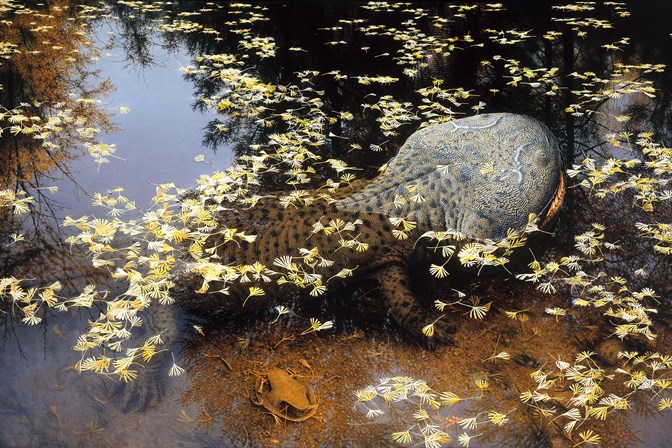Victoria's 'kool' new State Fossil Emblem Koolasuchus cleelandi
Following a public vote, the Victorian Government today announced Koolasuchus cleelandi as the official State Fossil Emblem of Victoria.
Following a public vote, the Victorian Government today announced the 125-million-year-old extinct amphibian, Koolasuchus cleelandi, as the official State Fossil Emblem of Victoria.
In August 2021, 11,563 Victorians voted for their favourite fossil to be crowned as the state’s official fossil emblem via an online voting system, with the ‘kool’ Cretaceous creature winning the mantle.
Koolasuchus cleelandi was a car-sized amphibian that lived alongside dinosaurs in Victoria during the Cretaceous period approximately 125 million years ago. Resembling something between a huge newt and a crocodile, Koolasuchus was adapted to life in the rushing rivers that once separated Australia and Antarctica. Fossils of the extinct amphibian have only been found at a few beaches and coves in South Gippsland on Bunurong Country.
Koolasuchus cleelandi will join other state emblems of Victoria: Leadbeater’s Possum, the Helmeted Honeyeater, the Common Seadragon, Common Heath, our state mineral, gold and our state tartan. Visitors can see Koolasuchus cleelandi on display in the 600 Million Years exhibition in Melbourne Museum’s Science and Life Gallery.
Lynley Crosswell, CEO and Director, Museums Victoria said: ‘Victorian state emblems recognise and celebrate the natural history of our region. Museums Victoria is renowned for our palaeontology collection with exceptional fossils from internationally significant fossil sites across Victoria. We are the custodian of these fossils, we display them, research them and keep them safe for future generations to learn from. Koolasuchus cleelandi is of global significance and it provides clues to the evolution of life on Earth and the past environments of Victoria.’
Danny Pearson MP, Minister for Creative Industries said: ‘While it might not be a creature you’d want to come across in the wild, the Koolasuchus cleelandi tells a fascinating story about Victoria's history – and we welcome it as our official fossil emblem.’
About Koolasuchus cleelandi
Koolasuchus cleelandi is an extinct temnospondyl amphibian that lived alongside dinosaurs in Victoria during the Cretaceous period approximately 125 million years ago.
Fossils of Koolasuchus were first found in 1978 near San Remo, South Gippsland, Victoria on Bunurong Country. In 1990 Michael Cleeland found the jaw that became the holotype of the species which was described in 1997. Lesley Kool spent months preparing the specimens which carries her name and that of Michael Cleeland. Koolasuchus is also something of a play on words as this species lived in a cool environment when Victoria was deep in the southern polar circle. Also, 'Souchos', Greek for crocodile, is commonly used in naming temnospondyls because their bodies are similar in shape to those of crocodiles.
The rocks Koolasuchus was found in were deposited during the Early Cretaceous (around 125 million years ago) in what would have been a large flood plain in a rift valley that formed as Australia was separating from Antarctica. At that time Victoria was within the Antarctic circle and the climate would have been cool, though the entire planet was warmer in the Cretaceous so the polar climate would have been warmer than the poles today.
Interviews available with:
- Dermot Henry, Head of Sciences, Museums Victoria
- Tim Ziegler, Collection Manager, Vertebrate Palaeontology, Museums Victoria
For media enquiries, please contact:








